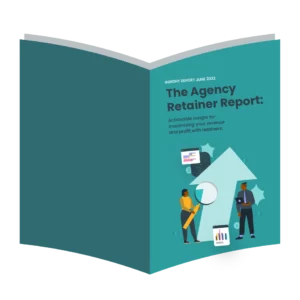When you’re dedicated to your agency because you love the work, focusing on profit can feel disingenuous. But there’s no getting away from the fact that, in order to keep working on the builds and projects you love, you need to be generating profit.
As agencies pivot to prepare for the possibility of recession, they inevitably turn to their business structures to understand where there are opportunities for cost-saving initiatives, as well as potential areas of growth. Plus, the more visibility agency owners have over their financial situation, the better prepared they are to navigate any future challenges.
We’ve written before about the role of retainers in increasing that all-important revenue visibility, thereby giving agencies the ability to better plan their investments and resourcing. But that’s only one half of the story. The other? That’s how to grow your revenue. We spoke with agency advisor Janusz Stabik to learn more about how agencies could be structuring their retainers to maximise their profit, ensuring healthier bottom-lines, and future-proofing for recession.
The agency advisor view
Janusz Stablik is a Managing Partner at GYDA, a specialist growth consultancy for digital agency leaders. GYDA mastermind groups and 1-2-1 coaching programmes are designed to help agency leaders to run better businesses. Through his advisory work, Janusz has developed a deeper understanding of how agencies operate – and where they commonly make pricing mistakes. “At the moment, there’s a fear of a recession,” says Janusz. “Spend is down.”
Either deliver small packages at low margin, but at scale, and say no to the consulting and tailoring. Or do the consulting, have fewer clients, charge larger amounts, and say no to all the commoditised, low-end stuff. Getting caught in the middle is the worst place to be; doing bespoke retainers for clients at a low fee.
This overall fall in customer spend has only exacerbated agency pricing issues. “Agencies are really fearful of putting prices up,” says Janusz, “often prices can remain stagnant for 10 years. Whereas we [GYDA] advocate for an annual price increase, particularly with inflation at the moment.
“You need to do that just to stand still.” But it’s not only due to issues with pricing that agencies are struggling to build their profit margins.

Make the most of your agency’s retainers.
Use our insight report to help you reimagine your retainers and raise your profits.Where retainer profit comes from
When delivering a retainer, it’s the balance of time, resources, and income (retainer fee) which delivers profit. If that balance is wrong, the retainer won’t deliver measurable profit – regardless of the up-front cost. This balance is exactly where Janusz identifies issues. “Lots of agencies are in a positioning nightmare,” he says, where they’re “caught in the middle” of two distinctly different approaches to retainers.
“Either deliver small packages at low margin, but at scale, and say no to the consulting and tailoring. Or do the consulting, have fewer clients, charge larger amounts, and say no to all the commoditised, low-end stuff. Getting caught in the middle is the worst place to be; doing bespoke retainers for clients at a low fee,” he advises. “Both sides are profitable,” but you have to “double-down” on your approach.
Aside from your approach to the size and type of clients you take on, or the retainers you offer, another big source of retainer profit are your outsourced services. By adding a mark-up onto the services you provide via third-parties, you not only cover your costs of using them, but also build extra profit into your retainers overall.
However, this is something that agencies have historically struggled to justify to themselves – something which Janusz would advise they become more confident in. He says, “That’s how your clients, and big brands are operating: they’re adding a premium onto the services and products that they provide, and it’s ok for you to do it too.”
“Profit is mark-up,” he says. “It’s free money. And that’s not a throwaway comment.”
What an optimised structure looks like
Retainers can vary massively in structure, contents and pricing – not only between agencies, but also between the customers that agency is in contract with, who each have their own individual needs and expectations. But just as there is a definite wrong way to approach retainers, there is an optimised ideal to strive for, too.

An optimised retainer structure will reduce pressure on agency staff, while ensuring maximum profit, and reducing the amount of time spent on re-negotiating with new business. We surveyed almost 200 UK agencies to understand how those in different turnover brackets were approaching their retainer structures, and our research identified a new best practice structure, which includes:
- Adding a mark-up to outsourced services, like hosting
- Establishing a retainer strategy which specifically targets new business
- Accounting for your overheads within your retainer pricing
You can read our full retainers best practice checklist in our report on agency retainer use, which is now available to download. For Janusz, the effort is well worth it. “Recurring, retainer-based services that you can deliver at scale help to really support bottom-line profit,” he says. But attitudes towards both retainers and profit also need to shift for agencies to see the most growth.
Losing clients is okay. If you’re not making a decent enough margin on services, your retainer fees are too low. Start charging for things you’re not charging for, and start charging enough.
Janusz Stablik, Managing Partner at GYDA
Embracing a profitable approach
“Profit is not a dirty word, it’s essential to a healthy business.” As agencies face down growing fears of an oncoming recession, optimising their retainer offering in order to ensure the most profitable returns is going to factor more and more into their future-proofing.
Janusz notes that this change is already happening; agencies now have more appreciation for retainers than they did a few years ago. “There’s a greater awareness among agencies that regular recurring revenue from clients is a good thing,” he says.
“More people are advocating for having a higher proportion of revenue from a retainer structure.” And, by optimising those retainers, you can really grow the level of revenue available via retainers – meaning that your agency is in the healthiest possible position moving forward.

